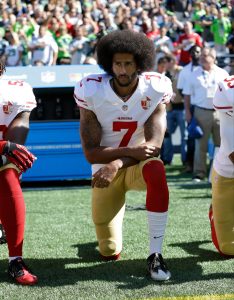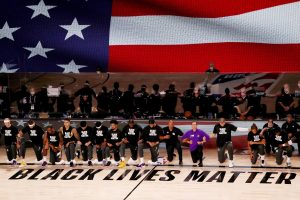1
Section One: The Fundamentals
A) What do we know about sport? What are common assumptions we make about sport and society?
| For decades, sports have been depicted as a means for achieving upward social mobility; however, in most cases, they perpetuate systemic inequalities by reinforcing existing barriers. Oftentimes, marginalized individuals are promised upward social mobility through sports, thus, resulting in a false sense of hope as they face limited opportunities due to structural limitations within communities. Athletes from low-income or underprivileged backgrounds frequently lack access to crucial means of achieving success, including not having access to quality training facilities, coaching staff, and support systems. As careers are short-lived, those who achieve prominence and professional status are frequently left without sustainable financial security or alternative career paths. One of my peers had a great example of how attempting to achieve upward social mobility in sports affects not only the individual attempting to achieve this mobility but hinders their family as well. The exemplification of a single parent reflects how this decision often impacts family members. A single parent cannot easily leave their full-time job to assist their child by bringing them to games or practices, nor do they have the financial stability to pay required dues and fees. Thus, this example showcases how upward social mobility is frequently restricted to privileged individuals, contradicting society’s inclusive portrayal of sports. In addition, the emphasis on sports as a “way out” of marginalized and poverty diverts attention from addressing the root causes of inequality, including discrimination, inadequate education, and economic disenfranchisement. Thus, this narrative pressures young athletes to succeed at all costs, often resulting in physical and mental exhaustion without guaranteeing a payoff.
|
Exercise 3: Notebook prompt
What are some other metanarratives about sport that you are familiar with? Find an image or video clip or draw something yourself that captures this idea…
So what? Why does any of this matter? Does it matter? As something we grow up with – live with – play through – we don’t often interrogate the meanings of sport, and perhaps we don’t want to.
But being aware of these assumptions and metanarratives is especially important, I would argue, because of the centrality of sport to our everyday lives, the role that sport plays in shaping our childhood and worldviews and….. [finish that thought]
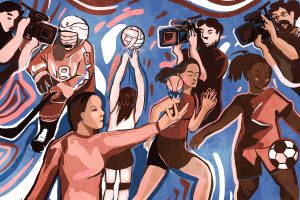
1. Sports are frequently celebrated as a space where talent and hard work prevail; however, they reinforce systemic inequalities in representation, access, and funding, reflecting the metanarratives of sports. Aspects such as economic privilege, racism, and sexism continue to shape opportunities, leaving the playing field far from level. Moreover, portraying sports as an underlying global force often masks how sports strengthen societal division. Factors such as nationalism, corporate interests, and political agendas must be considered as they prioritize profits and power over meaningful solidarity and progress. In most cases, sports do not address systemic disparities; they exploit and reinforce existing hierarchies, breaking the promise of being a means of empowerment. The selected image critiques the dominant narrative that sports inherently promote empowerment and visibility, particularly for women and marginalized groups. Thus, this image calls attention to these contradictions, challenging audiences to question who truly benefits from sports on a global platform. This image shifts the celebratory narratives of sports to express the barriers that weaken its potential for true inclusion and equity. When reflecting upon these dynamics, the image accentuates how it is essential to confront inequities within sports in order to reimagine their role, generating a more inclusive and transformative vision. 2. Sports truly do matter. Sports are something a person grows up playing or routing for a team. Sports facilitate an understanding of broader societal relations often masked as structural inequalities within societal values, making systemic barriers seem invisible or insignificant. They represent more than just a game; sports are a cultural phenomenon that showcases metanarratives that, ultimately, influence identities, reinforce societal norms, and reflect societal values. This is the case as sports have become engrained into societal life, causing us to overlook its implications. This interrogation of sports reveals the amount of power it has in perpetuating hierarchies of race, gender, and class. Its role in generating community and its ability to exploit and exclude are mirrors of societal inequalities while also providing a stage for change. As a society, if we neglect to question its meaning, we will not understand how deeply sport influences who we are and the systems that govern us. Therefore, as we interrogate sport, we discover its ability to reinforce and disrupt social narratives, underscoring why the space cannot be dismissed as merely play. 3. …the way sport reflects and reinforces societal norms, values, and power dynamics. Through its representations, rituals, and institutional structures, sports echo cultural attitudes regarding gender, race, class, and ability while actively influencing them. Thus, sports function as a means where dominant ideologies are both challenged and reproduced, making it an essential factor for understanding broader social inequalities that shape resistance opportunities. |
B) What is social justice?
Exercise 4: Padlet Prompt
Think back to the last section and try to look at some of the ideas we discussed differently. How might sport and social justice actually co-exist?
Record any images, video clips, or gifs you added to the padlet and identify a point of intersection between sport and social justice (can be an issue or a barrier or a debate or something you would like to explore in more depth in this course) . Screenshot or paste in your response below.
| Colin Kaepernick Takes a Knee for National Anthem https://www.youtube.com/watch?v=bBdoDOXMWkg
NBA: The Truth Is #BlackLivesMatter https://www.youtube.com/watch?v=1hJIuVvVQKk
Sports and social justice intersect as a powerful platform for activism, capable of challenging systemic inequalities and generating community solidarity. Athletes frequently leverage their public visibility to spotlight social issues, exemplified by Colin Kaepernick’s kneeling protest during the national anthem and the NBA’s advocacy for racial justice through initiatives such as “Black Lives Matter” messaging on basketball courts and jerseys. These actions demonstrate the ability of sports to transcend entertainment, creating space for meaningful dialogue on societal inequities. However, the commercialization of sports introduces challenges to the transformative potential of such activism. Corporate sponsorship, often driven by profit motives, can dilute the messaging of social justice movements. While companies may publicly align with these causes, their actions frequently reveal contradictions, such as failure to address their exploitative practices or a lack of diversity in leadership. This tension between activism and corporate interests raises questions about the authenticity and sustainability of using sports for social change. Despite these challenges, sports remain an influential cultural space for advancing social justice. By generating large audiences and forming emotional connections, athletes and leagues can inspire action, spark conversations, and challenge the status quo. As the global sports community continues to navigate the challenge of balancing activism and commercial interests, the potential for collective resistance and transformative change remains, underscoring how it is essential to preserve sports as a transformative platform for advancing social justice. |
C) Social Justice Reading
(note: this activity is optional!)
D) KINESIOLOGY AND SOCIAL JUSTICE
Exercise 5:
Exercise 6:
What are the implications of bodies-at-risk discourse and the refusal to understand the health gap from a social justice perspective, according to the authors of this article?
| The bodies-at-risk discourse positions marginalized groups as inherently deficient and accountable for their own health disparities, reinforcing whiteness as the normative standard while strengthening inequities. This narrative diverts attention from systemic oppression, portraying health outcomes as consequences of individual shortcomings instead of from ongoing structural barriers that marginalized communities endure. Consequently, this effectively silences the voices of marginalized groups, erasing their lived experiences and dismissing the broader sociopolitical forces that shape health disparities. Such a framework perpetuates harmful stereotypes, portraying marginalized bodies as “problematic” while normalizing whiteness and privilege as ideals. This focus on personal responsibility ignores the role of racism, sexism, poverty, and other structural determinants that systematically disadvantage marginalized communities. For instance, disparities in access to quality healthcare, economic opportunities, and environmental risks remain unaddressed when individual blame becomes the dominant narrative. Failing to approach health disparities through a social justice lens ensures these inequities persist. It prevents the implementation of policies and practices that address root causes and empower affected communities. Additionally, it delegitimizes collective struggles for equity, depicting systemic failures as personal shortcomings instead of societal obligations. To dismantle these harmful narratives, health discourse must shift from blaming individuals to addressing the systemic barriers and structural violence shaping health outcomes. Thus, centering the experiences and expertise of marginalized communities is vital to creating equitable solutions that challenge entrenched inequalities and disrupt the perpetuation of oppressive norms. |
Section Two: Sport Feminism
Exercise 7: Notebook Prompt
What is feminism? What does it mean to you? Choose one of the images below and explain how it captures your understanding of feminism (or find one that does speak to you and paste this into your pressbook with an explanation of why it matters to you.

Feminism, to me, represents the pursuit of equality with the dismantling of oppressive systems that perpetuate inequality by focusing on valuing individuality and diversity. Feminism challenges patriarchal structures along with the interconnected systems of oppression. Feminism seeks to create a world where all individuals, regardless of gender, can live free from marginalization, violence, and discrimination. Frida Kahlo exemplifies this through her defiance against the need to fit into social norms. She challenged traditional social conventions and gender roles, as she often dressed in men’s clothing, with her facial hair on her upper lip and her unkept eye browns, usually accentuated in her many self-portraits. An avid supporter of women’s rights, she provided a voice to unspoken feminist issues such as abortion and miscarriage through her artwork. Kahlo reminds us that feminism is about dismantling oppression and celebrating the courage to be oneself, making her a timeless symbol of strength and defiance in the face of societal expectations. |
Exercise 8: Notes Prompt (optional)
NB: Cornell notes is a great resource that teaches effective notetaking. Unfortunately, our system can’t save notes taken in the H5P app, so this is fully optional.
Exercise 9: Crossword Activity
Exercise 10: Padlet Prompt
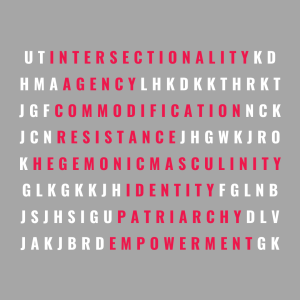
Intersectionality is vital in sports and social justice as it recognizes how overlapping identities, including gender, race, and class, create unique experiences of discrimination or privilege in sporting contexts. This framework supports the development of inclusive practices and policies that address systemic inequalities, ensuring representation and fair access. Agency is essential in sports and social justice as it underscores individuals’ ability to act and make choices within and against structural constraints. Emphasizing agency allows individuals to understand how athletes and activists navigate, resist, and reshape systems of oppression, generating empowerment and transformative change. Commodification is crucial in sports and social justice as it stresses how cultural, social, and athletic practices are turned into marketable goods, frequently prioritizing profit instead of human value. This process can exploit marginalized groups while opening opportunities to challenge and reshape narratives through consumer-driven activism and representation. Resistance is central to sports and social justice as it represents the active efforts to challenge and disrupt systems of oppression and inequality. Through acts of defiance, individual and collective athletes create spaces that question dominant norms and advocate for transformative change. Hegemonic masculinity is significant in sports and social justice as it underlines the dominant norms of masculinity that prioritize power, aggression, and competitiveness, frequently marginalizing other gender expressions. Understanding this concept aids in challenging inequitable power dynamics in sports and promoting more inclusive and diverse representations of gender. Identity is fundamental in sports and social justice as it shapes how individuals and groups experience inclusion, exclusion, and recognition within social and athletic contexts. Exploring identity exposes how intersecting factors such as gender, race, and class influence personal and collective narratives, driving efforts toward equity and representation. Patriarchy is critical to discussions in sports and social justice as it highlights the systemic power structures that privilege men and masculinity while marginalizing others. Addressing patriarchy in sports reveals how gendered hierarchies perpetuate inequality, enabling transformative efforts toward equity and inclusion. Empowerment is necessary in sports and social justice as it enables individuals and communities to gain agency, confidence, and control to challenge systemic barriers. Through empowerment, marginalized groups can augment their voices, reshape narratives, and create equitable change. |
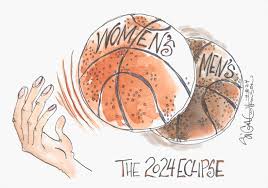
| The landscape of women’s sports is shifting, driven by athletes such as Angel Reese and Caitlin Clark, who are generating unprecedented enthusiasm and visibility. Their success and charisma captivate audiences, signifying the potential for women’s sports to thrive. However, systemic barriers hinder sustained progress; this includes disparities in unequal funding, limited media coverage, and ingrained cultural biases. While interest in women’s sports is undeniable, assuming this momentum will naturally lead to permanent change is a mistake. Consistent investment and societal support are fundamental to transforming this enthusiasm into lasting equity. Financial support provides athletes and teams with the resources needed to excel, increasing achievement and engagement. Media representation is also critical in normalizing women’s sports as mainstream entertainment, creating a culture where girls and young women see pathways to success and recognition. Furthermore, to address cultural biases, it is a necessity to challenge outdated narratives that devalue women’s athletic achievements while endorsing gender equity across all levels of sport. The current surge in interest shows that people care about women’s sports, but to keep this support, collective action is essential. Fans, media outlets, sponsors, and policymakers must work together to dismantle barriers and build infrastructure for sustained growth. The progress led by athletes such as Reese and Clark is a testament to what is possible. Thus, by actively supporting women’s sports, society can ensure this moment becomes a turning point instead of a momentary trend. |

